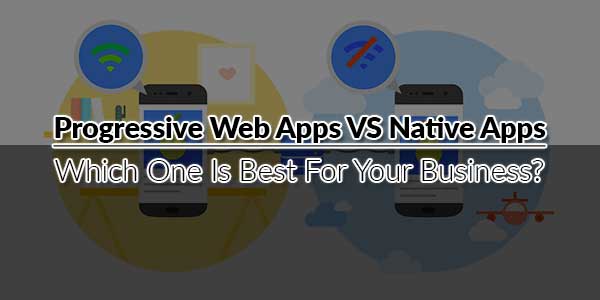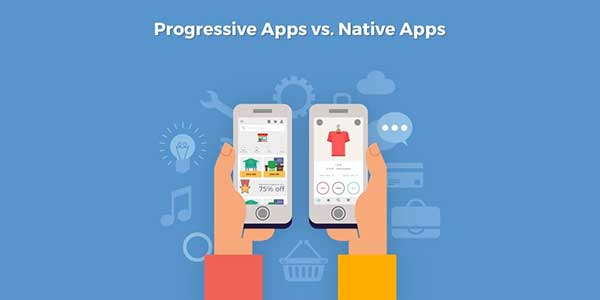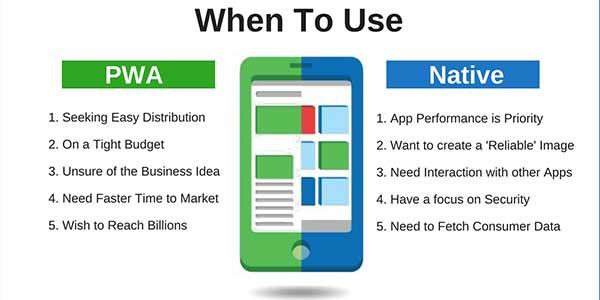
With the advent of furiously dynamic digital technology, businesses are on a constant run to grab newer opportunities to enrich the customer experience of their users. Great customer experience begins with “making things simple” for the customers.
Many businesses have already progressed from websites to smart mobile apps and responsive sites while offering services to their customers. Earlier, mobile app development was centered around two options- either developing a mobile website or developing a native app with the help of tools available on Android and iOS.
Presently, there is a third option that is gaining a lot of popularity: The Progressive Web Apps (PWAs). Assuring moderate and easy mobile apps without any shortcomings, PWAs are frequently hailed as the most ideal way to build a mobile presence, yet there are many who debate whether the PWAs are truly as great as they appear to be.
Let us clear the air by comparing Progressive Web Apps with Native Apps. Keep reading…
Table of Contents
Progressive Web App Vs Native App:
Advanced technologies for mobile app development depends on various factors such as the device used, app tested, development time, a ratio of the lines of the code of errors, and so on.
The most ideal way is to make a relative correlation dependent on the general advantages and disadvantages of the hidden architecture design of the technology.
Let’s use the following paradigm to assess the app development methods, and make a good decision for your mobile app.
Write Once Use Universally:
Native applications expect you to create and maintain a different codebase for various platforms. Java or Kotlin is used to create Android applications and Objective-C or Swift is used to create iOS applications. Whereas, PWA support reusability of code.
Both of them use web technologies such as HTML, CSS, and JavaScript to make the application. Native apps may need to maintain discrete branches if the factors are styled to cling to platform-specific design language. On the other hand, PWAs support the maximum quantity of code reusability.
Learn Once Apply Throughout:
Just like codes, programming languages used to create native apps once learned can be used everywhere. All you need is to understand the technologies and concepts involved in programming languages.
Figuring out how to create apps using technologies reduces the time required to learn distinctive programming dialogues and their uses for various mobile platforms. The additional advantage of the latter approach is that it permits to create applications for the web and existing web developers can experience smooth progress into mobile app development.
Performance:
This is commonly considered as one of the most significant factors that developers can’t disregard since it influences the number of users of the application as well as the retention rate. Native applications have the best performance because of the optimizations available and running on the device.
The native app additionally has great performance since the factors identified with user interface (UI) are native in nature. Whereas, PWA has an even better performance than native because of the architectural design which compiles the code first to ARM C/C++.
The Imperative Benefits Of Progressive Web Apps:
- Progressive web apps are future-forward as they are extremely responsive, adaptable, and fresh. They can be used on the tablet, mobile, desktop, or any other gadget without bothering size.
- When PWA is dynamic in the internet browser, the user can get pop-up messages through it, or add it to the home screen to get to the application quickly. It is crucial to saving data to preview the app offline as developers work offline or when the system is low or not working.
- Despite the fact that you use a PWA in the browser, it feels like an app, thereby providing the app-style interactions and navigation, which are based on a native app template.
- Users don’t need to install the app as well as the updates, although a user can run the app on their mobile phone’s home screen.
- Moreover, PWAs are discoverable, linkable, and re-engageable. It’s normal to get a native mobile app developer supporting PWAs.
There are several features in a PWA that offer a web-like and app-like feel. These include:
- Push messages
- Local notification
- Clipboard
- Camera and mic
- Vibration
- Geolocation
- Fullscreen
- Battery status
- Device orientation
- Touch gestures
- Gadget direction
- Adding an icon to the home screen
As a kind of hybrid app development, PWA uses fewer data from the internet as it collects regularly used resources on the device. This feature makes it look amazing and very powerful.
Progressive Web Apps Score Over Native Mobile Apps:
PWAs are considered better than native apps as they combine the features of both- web and native app experience. With a native app, users have to download and install them on their mobile phones. If space is constrained, the user should make a space for the new app by removing other already installed apps.
Users might love the native app but they can be accessed only if the internet connection is working. Once the more efficient or the newer apps are downloaded, the older apps automatically get deleted to create space on the device. It is evaluated that most of the users of eCommerce and retail apps use the app just for a month after downloading as it takes too much time to download.
Research demonstrates that mobile apps that have pop-up messages keep multiple times a greater number of users than those without it and users are significantly more prone to revive an app than a site. This shows applications can definitely be put to great use. This is the place where a progressive web app comes into the picture.
Conclusion:
When it comes to choosing any one app for your business, both – Native as well as progressive web apps- would do better at their respective places. Both give advantages to their users and offer them the flexibility to pick how they like to access the brand.
But, as the future is betting more on PWAs, businesses should look to leverage the benefits of progressive apps. They reduce the cost of the data and target both mobile as well as desktop users at one go. Now, it is the right time to chose one of the most promising apps for your business – the Progressive web apps.

 About the Author:
About the Author:
















Be the first to write a comment.